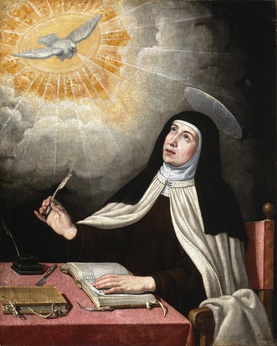
A Grace-Filled History
She who has God, finds she has everything. God alone suffices.
-St. Teresa of Avila
The Order of the Blessed Virgin Mary of Mount Carmel was instituted to honor the Mother of God, and it was the first Order established in her honor. A tradition of many centuries identifies the first Carmelites with the hermits of Mount Carmel, disciples of the prophet Elijah and Elisha. We recognize in our Father St. Elijah, the inspiration of the Carmelite life, dedicated to contemplation and solitude, and burning with zeal for the glory of God. St. Elijah accomplishes his work, and passes on his spirit, leaving behind him a spiritual following.
For centuries the eremitical life flourished on the slopes of Mt. Carmel. The cenobitical life was organized around the year 1210 A. D. and the superior, Broacard, asked and obtained from the Patriarch of Jerusalem, St. Albert, a rule which confirmed and expressed concretely their purpose of “living in obedience to Jesus Christ.” As tensions increased in the Holy Land, shortly after the last crusade, it became impossible for the Carmelites to continue their observance and so the Order spread to Europe, where it increased and spread rapidly. In England, particularly, the Carmelites flourished under the holy generalship of St. Simon Stock. This saint had a most tender devotion to the Mother of God, who bestowed upon him the gift of the Scapular and her promise of protection for the Order.
The establishment of Carmelite nuns is generally attributed to Blessed John Soreth, who had labored for the restoration of the Primitive Rule in the 15th century. He established convents in the Order, obtaining permission from Rome for this purpose; however, there is authentic evidence of Carmelite nuns existing long before, during the lifetime of St. Simon Stock. Many regional reforms continued, though none was successful in reaching the entire Order until the time of St. Teresa of Jesus, with the foundation of the Carmel of St. Joseph of Avila, on August 24, 1562.
St. Teresa of Jesus had entered the Monastery of the Incarnation in 1535. After a long struggle with the daily practices of mental prayer and after receiving special graces from God she reformed the order. The contemplative nuns of her community dedicated their lives to the service of the Church. As a part of the reform, St. Teresa decided to include a group of friars who would share in the kind of life lived by the nuns. Her aim was to provide spiritual directors who had the same spirit and to provide the Church with a variety of apostolic activities. These friars and nuns became known as the Order of Discalced Carmelites.
Our Holy Mother Teresa established her monasteries under the observance of the Primitive Rule, presenting the prioress as the center and soul of community life, and life founded on charity and joyfully enclosed by voluntary cloister, thus providing a desert much like the ancient hermits who St. Teresa would have her daughters imitate. She recommends humility as the foundation of all the other virtues, especially charity, and a free and generous obedience. St. Teresa imparts to the Order and apostolic and ecclesial spirit, desiring to come to the aid of the Church in her day as it was being rocked to its very foundation by the Lutheran heresy. In addition, she left her own characteristic stamp of simplicity and radiant joy.
In order to consolidate her work, undertaken at our Lord’s direction, St. Teresa wrote Constitutions which together with the primitive rule have governed the Discalced Carmelite nuns from their beginnings and which Our Holy Mother left as a heritage to her daughters. St. Teresa gained for the Order Saint John of the Cross, who assisted in spreading the reform to the Carmelite Friars six years after the nuns. St. Teresa of Jesus herself showed St. John of the Cross the Carmelite ideal of which he would later be the consummate master, bequeathing marvelous treatises to the treasury of the Church.
The ends of the Teresian Reform, and the means which must be employed to attain them are well defined. St. Teresa of Jesus, assures us that “love does not consist in great delights, but in desiring with strong determination to please God…to continuously seek His honor and glory, and the increase of the Catholic Church.” She tells us that there is no better way to attain these ends than to fulfill the evangelical counsels with all possible perfection and to be occupied in prayer that the Defenders of the Church, Preachers and Theologians, may advance in holiness, and be on the alert to safeguard her sound teachings and morals. She wishes her daughters to live in such a way that by their virtues they may merit an abundance of grace for these Champions of the Faith, that they may be fortified and sustained in their spiritual combat amid the dangers and allurements of the world.
Carmel endeavors to give increase to the Church by a “hidden apostolic apostolate, by its withdrawal from the world and the exercises proper to the contemplative life.” Its mission and vocation is prayer in the Church and for the Church. “There is no love for Christ which is not converted into a generous surrender to the Church, and there is no filial affection for the Church if it is not expressed in apostolic fervor and work.”
“Oh my Sisters in Christ, help me to implore this of Our Lord. That is why He has brought you here, this is your vocation, these must be your concerns, these must be your desires, these your tears, these your petitions. Happy the lives that are consumed in this way!”
– St. Teresa of Avila



